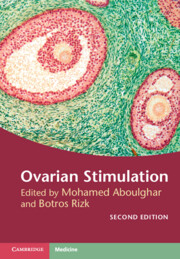Book contents
- Ovarian Stimulation
- Ovarian Stimulation
- Copyright page
- Dedication
- Contents
- Contributors
- About the Editors
- Foreword
- Preface to the first edition
- Preface to the second edition
- Section 1 Mild Forms of Ovarian Stimulation
- Section 2 Ovarian Hyperstimulation for IVF
- Chapter 6 GnRH Agonists for Ovarian Hyperstimulation
- Chapter 7 Role of GnRH Antagonist in Assisted Reproduction
- Chapter 8 Gonadotropins in Ovarian Stimulation
- Chapter 9 Egg Donation: Implications for Counseling Donor and Recipient, Donor Preparation, and Recipient Preparation
- Chapter 10 Progestin-Primed Ovarian Stimulation
- Chapter 11 Ovarian Stimulation in Poor Responders
- Section 3 Difficulties and Complications of Ovarian Stimulation and Implantation
- Section 4 Non-conventional Forms Used during Ovarian Stimulation
- Section 5 Alternatives to Ovarian Hyperstimulation and Delayed Transfer
- Section 6 Procedures before, during, and after Ovarian Stimulation
- Index
- References
Chapter 6 - GnRH Agonists for Ovarian Hyperstimulation
from Section 2 - Ovarian Hyperstimulation for IVF
Published online by Cambridge University Press: 14 April 2022
- Ovarian Stimulation
- Ovarian Stimulation
- Copyright page
- Dedication
- Contents
- Contributors
- About the Editors
- Foreword
- Preface to the first edition
- Preface to the second edition
- Section 1 Mild Forms of Ovarian Stimulation
- Section 2 Ovarian Hyperstimulation for IVF
- Chapter 6 GnRH Agonists for Ovarian Hyperstimulation
- Chapter 7 Role of GnRH Antagonist in Assisted Reproduction
- Chapter 8 Gonadotropins in Ovarian Stimulation
- Chapter 9 Egg Donation: Implications for Counseling Donor and Recipient, Donor Preparation, and Recipient Preparation
- Chapter 10 Progestin-Primed Ovarian Stimulation
- Chapter 11 Ovarian Stimulation in Poor Responders
- Section 3 Difficulties and Complications of Ovarian Stimulation and Implantation
- Section 4 Non-conventional Forms Used during Ovarian Stimulation
- Section 5 Alternatives to Ovarian Hyperstimulation and Delayed Transfer
- Section 6 Procedures before, during, and after Ovarian Stimulation
- Index
- References
Summary
Half a decade ago, we witnessed the culmination of much of what we comprehend today in classical ovarian endocrinology and physiology [1;2], human embryology [3] as well as clinical ovarian ultrasonography [4]. Much of the former was based upon the development of (radio-)immunoassays that could reliably detect low concentrations of hormones in body fluids, including the peripheral circulation. This meant that correlations of hormone concentrations and specific physiological events could be determined with precision, leading to many advances in clinical practice and drug development. The biological control of all these physiological elements is, of course, gonadotropin-releasing hormone (GnRH), whose decapeptide structure was elucidated by Andrew Schally and colleagues in 1971 [5], for which he was awarded his share of the Nobel prize in 1977. His co-prize winners were responsible for the pioneering of immunological competitive binding dilution assays, which underwrote all these developments.
- Type
- Chapter
- Information
- Ovarian Stimulation , pp. 55 - 64Publisher: Cambridge University PressPrint publication year: 2022



